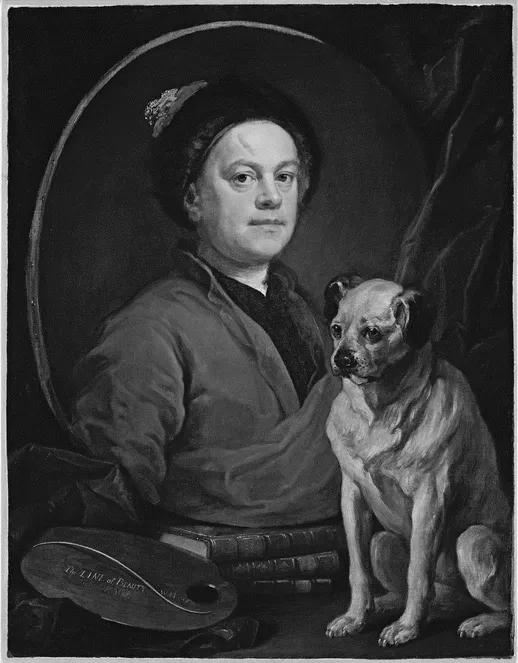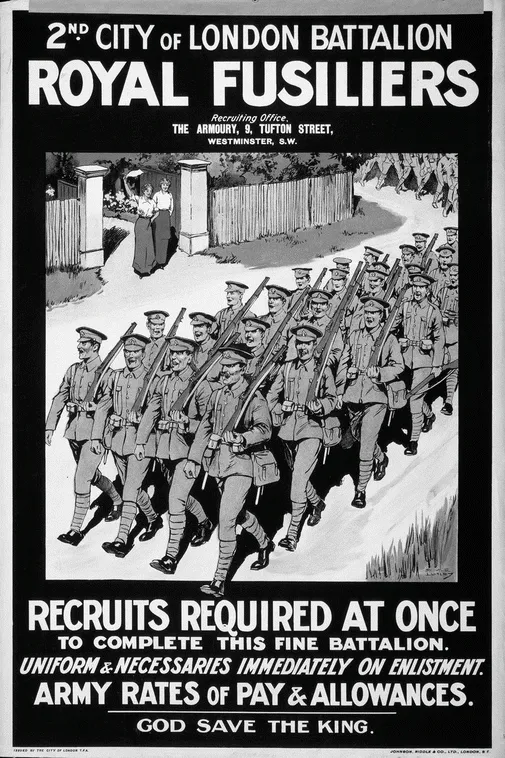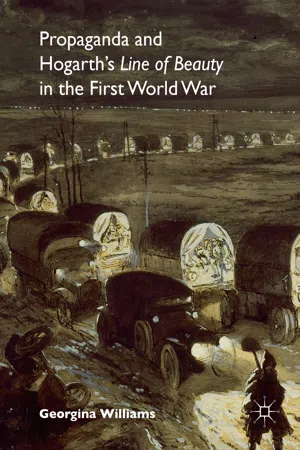Within the wider fields of art history and visual culture, the focus of this book is early twentieth century pictorial conflict propaganda related to the First World War. This investigation sets out to isolate a specific visual construct not usually associated with artwork of this genus, and thereby explore what its presence within the works we study represents. The construct utilised as a tool for the unpacking of the imagery is not one that has been chosen at random, but, rather, selected for its genealogical legacy. Of equal importance is the construct’s connotation as both a literal and metaphorical representation of movement. The pertinence of this latter consideration lies in the concept of a propagandist promotion of an alternate reality as a challenge to a current ‘real’. Consequently, the potential for circular cause and consequence relating to competing constructions of the real suggests conditions of possibility whereby the metaphorical movement between them can be aesthetically represented by a literal, visual construct. The construct serving as a pictorial trope deemed to represent not only movement but movement at its most beautiful, thereby forming a focus to attract the viewer, is the ‘serpentine line’ that in 1745 artist and theorist William Hogarth scribed on a paint palette and titled ‘THE LINE OF BEAUTY’ [capitals in the original], as exemplified in Fig.
1.1.
1 In trying to ascertain a ‘grammar’ within the artworks he was being forced by convention to copy, Hogarth sought a language he could interpret, of which the serpentine curve—the line of beauty—became the catalyst, as he was later to record in his 1753 book The Analysis of Beauty. Joseph Burke comments that for Hogarth ‘Memorizing was helped by a natural impulse to abstract the salient’ and speaks of the artist whose predilection is ‘for seizing the essential in the abbreviated form’.2 These remarks are endorsed by Hogarth’s own declaration that ‘the most striking things that presented themselves made the strongest impressions, in my mind’.3 Of additional interest in this respect is Jean Baudrillard’s more recent declaration that ‘We need a visible past, a visible continuum, a visible myth of origin, to reassure us as to our ends...’,4 and the importance of the line of beauty as a ‘visible continuum’ will be demonstrated as this book progresses. There is a correlation between these observations and the reasoning that lies behind the construction of concise propagandist messaging conceived for the specific purpose of distribution via, for example, the pictorial poster. For this medium to be effective the propagandist needs to create imagery comprising visual constructs capable of ‘striking’ the viewer, in order for each individual to perceive and subsequently extract that which the propagandist considers to be crucial.
The propaganda artwork under examination here is primarily restricted to that associated with the First World War, although the premise of this investigation suggests a genealogy which threads into other eras and these are therefore acknowledged throughout. However, the importance of this era is that it is in these early years of the twentieth century that the pictorial poster was first exploited by the state
5 and subsequently used as a tool for the distribution of propagandist messaging. In addition, propaganda as a concept was beginning to be considered in the context we now understand, a point examined later in this chapter. Of prime import is the recognition that
As the war’s meaning began to be enveloped in a fog of existential questioning, the integrity of the ‘real’ world, the visible and ordered world, was undermined. As the war called into question the rational connections of the prewar world—the nexus, that is, or cause and effect—the meaning of civilization as tangible achievement was assaulted, as was the nineteenth-century view that all history represented progress.6
Certainly in Britain at least a ‘tiny social elite held the threads of social, economic and political power firmly in their grasp’,
7 and the ‘self-conscious modernism’ particular artists and writers possessed assisted in jeopardising the ‘cosy certainties’ of an age that long before August 1914 was already effectively obsolete.
8 Futurist and Vorticist modernity contributed to these innovations in art and expression, resulting in artworks informed by fascination with technology, movement and speed, and which results in an inevitable association with the ‘first truly modern war’.
9 Mark Wollaeger maintains that at the commencement of the twentieth century ‘modernism and modern propaganda emerged as mutually illuminating responses to modernity’
10 and when this is articulated through the pictorial it generates artworks of both propaganda and
counter-propaganda provenance, as neither operate in isolation. During this era the propaganda poster, an example of which is illustrated at Fig.
1.2, inevitably instigated a counter-propagandist aesthetic response, regardless of whether or not the artist’s intention was consciously reactive.
The direct association of the Savile Lumley poster (Fig. 1.2) to these considerations reflects Joseph Burke’s comment that there is a necessity for capturing what is critical, not least in the idea behind the ‘visual ellipsis’. This concept is a logical premise in respect of this study, because when the serpentine curve as a line of beauty is utilised, and subsequently perceived, as a visible continuum, the potential recognition of the construct allows the viewer to expand, or invent, his or her own context. On viewing an image this results in form and content becoming inseparable from the context, with the consequence that any missing sections of the curvature can be implied. This is an acknowledgement of Hogarth’s reference to a line of beauty that is not necessarily seen in its entirety, consequently requiring the assistance of the viewer’s imagination in order to complete the structure.11 Important to assert at this point, however, is that the isolating of this visual trope, whether a complete or incomplete construction, is not about testing the attraction of the ‘line’ deemed to be a line of beauty for the specific purpose of proving its effect. This study concentrates instead on recognising the presence of the line within artworks—as Hogarth practised—yet with the focus upon artworks utilised for the distribution of conflict propaganda, and what the existence of the line of beauty as a contributory compositional element within them potentially signifies from both a literal and metaphorical point of view. The focus upon early twentieth-century pictorial conflict propaganda examined through the employment of an eighteenth-century aesthetic theory produces a unique combination of elements that not only affect each other and therefore the whole, but also illustrate a genealogical thread with the potential to permeate into the twenty-first century.
Propaganda is a complex subject, and differences undoubtedly exist between what is considered to be propaganda and what is meant by the more general term of information. Despite their close association, any discrepancy may feasibly lie in the propagandist’s aim of leaving the propagandised individual with an ‘impression’ rather than merely facts or figures.
12 From an historical perspective Wollaeger’s assessment that it was not until the 1950s that ‘the erosion of the distinction’ between the two was ‘theorized’ is worth noting.
13 Regardless of these considerations it is nonetheless still ‘information’ being conveyed, with the distinction apparent only in the propagandist’s intention and the propagandee’s subsequent perception of that information. That governments circulate propaganda because of a requirement to promote their achievements, thereby leading to ‘the dissemination of information designed to alter public opinion’
14 is noteworthy, because ‘dissemination of information’ is a pertinent expression when considered not only in the context of the distribution of propaganda in general, but in relation to a more focussed distribution in particular, as is the case during times of conflict. Moreover,
The public accelerates the transformation of information into propaganda because public opinion generally prefers the clarity of myth (propaganda’s specialty) to a chaotic profusion of facts, and there is simply too much information in circulation for most people to process.15
This highlights the relevance of a concise propagandist message in focussing the attention of the propagandee, and the medium of, for example, the poster as a method for distribution which includes within its composition a construct with the ability to attract—such as the
line of beauty—is productive for the purpose. During the twentieth century the dictionary definition of the word ‘propaganda’ changed, from a 1913 designation of ‘…any organization or plan for spreading a particular doctrine or a system of principles’
16 to a more recent entry of ‘Information, especially of a biased or misleading nature, used to promote a political cause or point of view...’
17 However, hindsight enables the propaganda of the former period to be analysed utilising the explanation documented in the...


